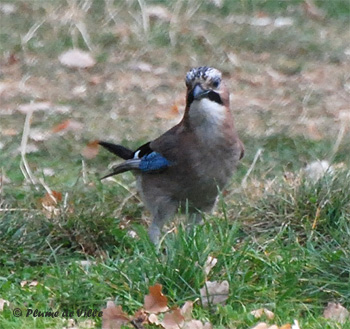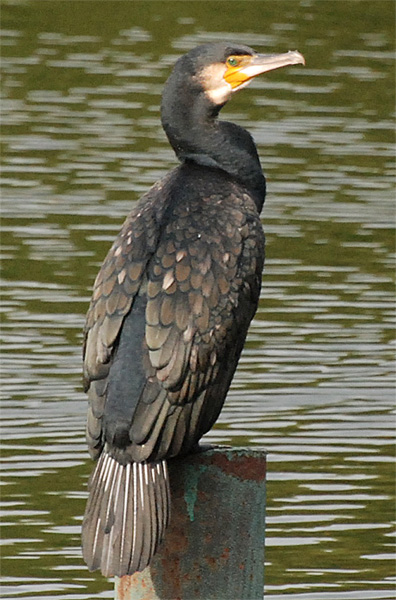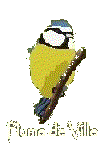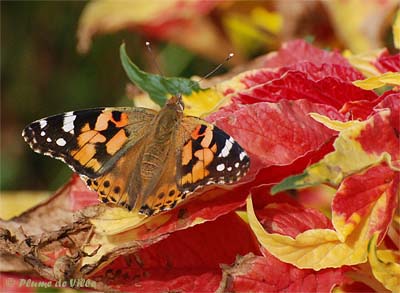Plume de Ville
From day to day.
October 2009
October 1st
Gray dotted
beige brown, it is very young.
One can just imagine at the freckles on his throat, its future red bib of European
robin that it will acquire after its first moult
[Juvénile Rougegorge
familier]
(Paris 23 Sept 2009)
October 2nd
Forgery...
Caterpillar?
No. But "fake caterpillar" from which no butterfly will emerge, but
a small wasp, a sawfly.
These are these larvae that copy the larvae of Lepidoptera caterpillars but
counterfeiters have made a small mistake! They have more than five pairs of
prolegs (six for them) and that is how it is exposed.
They make funny movements, bowing, comma-shaped, simultaneously.
They devour with the appetite the leaves of this alder, which is also covered
of spawning Willow Emerald Damselflies
These tiny wasps lay eggs inside the leaves; the larvae attack the leaves
around them.
Probably Croesus septentrionalis whose larvae settle on alder or birch.
(092009)
Adults? I have not found
the adult for the larva above, but here are some other sawfly adults displayed
below.
They can be very different in appearance and there are about 800 species in
France.
Here is one
wearing striped socks, that I tried unsuccessfully to identify. It is seeking
the larvae above that I've finally found who it was.
It is a beautiful soft green
[Rhogogaster
viridis] (Tenthrède verte).
(09072009)
Wasp like....
This one donned a wasp
dress, very different. [Tenthredo (Allantus) scrophulariae].
(22062009)
And I leave
the last one covered with pollen in its buttercup as [Tenthredo sp.], because I
could not identify it.
(20052009)
(Un peu plus sur les Tenthrèdes?Le site A. Ramel Avec un grand merci pour son site passionnant).
October 4th
Red Admiral [Vanessa atalanta - Nymphalidé -] (Vulcain) It fluttered on the stones where they like to alight to lick the of from fallen ripe fruits, grapes that day, too ripe the better it is! Only by seeing the picture closely I found her bad condition. It has surely much flied, its wings make you think of an old scrap of paper.
Another
migratory.
He began to arrive in late April. In autumn some adults of the last generation
can do the south journey.
A touch of patriotism in the underside.
(Paris Sept 2009)
October 5th
Come back.
I see them more regularly.
Intriguing
to see this group of insects that resemble the well known classic "firebugs"
without the good drawing.
These are well bugs called "firebugs" ("gendarmes" in French)
but here they are "young". They are still in the larvae state (called
pre-imaginal larvae) just until before their final moult.
For larvae, they have a really good adult activity.
(Paris 18 Sept 2009)
Adults here.
Firebug. [Pyrrhocoris apterus -
Heteroptera -] (Pyrrhocore aptère, Gendarme or Cherche-midi)
They are
often found in the sun in large colonies like this. They regroup in the fall.
Enigmatic
and hairy.
It's a Rose bedeguar gall (Robin's
pincushion gall, or Moss gall). A dog rose gall.
It is caused by a tiny wasp [Diplolepis eglanteriae or Diplolepis rosae] (Cynips
du rosier).
The insect lays its eggs in the stem of the wild rose that produces this amazing
formation. The larvae over winter inside and emerge the following spring.
6 octobre
A small
plum?
The fruit of decorative prunus. It seems she has tasted and not really liked
it. A moment latter it will drop the fruit. Actually the fruit of the tree are in
large quantities still intact.
Or a
beautiful beechnut? Much better.
Very fat and nutritious, they are much appreciated.
Some are hard to reach.
It also inspects the horse chestnuts.
Rose-ringed Parakeet. [Psittacula
Krameri] (Perruche à collier)
(Paris Oct 2009)
October 7th
A little farther, the Jay [Garrulus glandarius] (Geai des chênes).
He prefers to pick up acorns littering the ground
It carries tham in the pocket he has under his beak.
(Besides his neck here seems pretty big ...)

Especially
at this time of year he can go and hide them under the bark of a tree or bury
them under fallen leaves.
(Paris Oct 2009)
October 9th
Butterfly of the year!
Again a painted
lady [Vanessa cardui] (Belle dame) in October.
They were particularly numerous this year to move north.
This one belong the latest fall generation and is very "fresh".
It will therefore perhaps have the chance to return to the country of its
grandparents or great-grandparents in Africa in the Maghreb countries, to spend
the winter at warm.
October 16th
It is not
very hot these days, so those two rest together sunbathing.
It is a little common wall lizard; its dragonfly companion is a common darter
which is about 4 cm long.
Not far away,
this Small Copper or Common Copper [Lycaena phlaeas] (Cuivré commun, Bronzé ) sits in the sun.
Always there, this little butterfly (2.5 cm), it flies long-time from spring until late
October. He has four generations a year.
This one, although a little tired, shined very nicely in the sun.
He lost a lot of scales but it so takes beautiful iridescent green colours.
This one, younger,
sports the bright orange colour of the small copper.
October 21th
The terror of pelargonium.
This pretty
little butterfly (2-2.5 cm) is actually a gardener invader!
It is a pest that attacks only the Pelargonium (geranium) culture. Not to
native geraniums (at least... for now, thankfully!).
This is the Geranium bronze [Cacyreus marshalli-Lycaenidae Polyommatina-] (Brun
du pélargonium).
His country of origin is South Africa; an accident deposed it in the Balearic
Islands, around the year 1988.
Since, he made his way, urban way because it loves cultured geranium. He
climbed slowly to the north and is present everywhere but is especially
abundant in the south. It is considered a pest.
He lays on the leaves, the stems and buds of pelargonium. Its caterpillar eats most
the buds and stem but from within, growing and digging the plant and
permanently destroying the entire plant.
Top evenly
brown fringed with white.
Hind "queue" with a small black ocellus surrounded by white.
It is found
from March to November.
Its caterpillar is first green and acquires pink lines over time.
It does not lay in the native geranium, its larvae can not feed on its vegetation.
It has no predators here and so it does as it likes with the geraniums. And
more, we keep them warm indoors during the winter... It is very difficult to
eradicate.
I found this Parisian installed on dahlias.
(Paris 191009)
http://www.leps.it/indexjs.htm?SpeciesPages/CacyMarsh.htm
http://www.lepinet.fr/especes/nation/carte.php?e=l&id=31021
http://www2.mnhn.fr/vigie-nature/spip.php?rubrique37
October 22th

All black
the Great black cormorant? Not! As a pinecone with emerald eyes.
Great Black Cormorant.
[Phalacrocorax carbo Pelecaniformes] (Grand cormoran)
October 30th
This little Mohican? A Mandarin duck.
[Aix-galericulata Anseriformes Anatidae-] (Canard mandarin)
It is native to eastern Asia. Introduced in England, he was naturalized.
Here in intermediate plumage. He lost his sumptuous wedding dress. After
reproduction, it loses its beautiful plumage in late spring; sometimes up to resemble
its brown female (it takes its eclipse plumage). He will resume its magnificent
wedding plumage gradually, even as soon as in autumn.
(P floral 191009 Minimes 221009)
Here it is
in spring in all its splendour.
It is a perching duck;
it nests high in a tree hole. Sometimes at 10 m high. The chicks
practice the jump... without elastic cord. Practically at birth, called
by their mother, they must jump into the void to leave their tree.
Small balls land without problems.
The female
is much more discreet. It is brown with white belly.
Red-billed, a small white spot for adults, dark beak and red spot for chicks.
(Montsouris 110408)
Also called "Carolina Duck".
It is from ... Carolina. He also has been introduced as a decoration duck. It is found less often released because there has less well acclimated than the Mandarin.
Like its
cousin, it is a perching duck which also nests in hollow trees and chick make also
the leap to leave the nest.
(Vaires 131009)




















